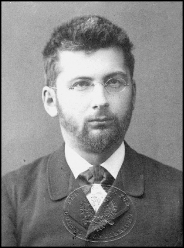- MARGULES
- POLAND (see also List of Individuals)\
 23.4.1856 Brody/UA - 4.10.1920 Perchtoldsdorf/A\Max Margules was born in today's Ukraine which formerly belonged to Poland. He studied physics and mathematics at the Vienna University: among his teachers was Ludwig Boltzmann. Margules went in 1879 to Berlin University to return to Vienna the following year as a Lecturer in physics. In 1882, he joined the Meteorological Institute as an assistant and remained there for the next 24 years. Margules was introverted and lonely, unable to collaborate with others. He was disappointed and disillusioned at the lack of recognition of his work and retired from the Institute in 1906. His colleagues tried their best to help him both mentally and financially, yet he died of starvation in 1920.\A number of outstanding meteorologists lived in Austria from 1890 to 1925, amongst which were Wilhelm Trabert (1863-1921), Felix Exner (1876-1930), Heinrich Ficker (1881-1957), Wilhelm Schmidt (1883-1936), Albert Defant (1884-1974) and Margules. He was one of the founders of dynamic meteorology and a brilliant theoretician who became famous only after his death. He studied the diurnal and semidiurnal variations in atmospheric pressure due to solar radiactive forcing thereby analyzing the Laplace tidal equations and deriving in 1893 two solutions which he called waves of the first and the second kind. This was the first identification of the two distinct types of waves presently known as inertia-gravity and rotational waves. In his 1904 paper, Margules considered the possibility of predicting pressure changes by direct use of the mass conservation principle. He concluded that any attempt to forecast the weather was "immoral and damaging to the character of a meteorologist". One interesting question about Margules' results is what influence they had on the approach of forecasting weather by Lewis Fry Richardson (1881-1953). It was concluded recently that neither Richardson nor Exner did explicitly use the approach of Margules.\Kutzbach, G. (1974). Margules, Max. Dictionary scientific biography 9: 107-108.Lynch, P. (2003). Margules' tendency equation and Richardson's forecast. Weather 58: 186. P Margules, M. (1881).Über die Bestimmung des Reibungsund Gleitcoefficienten aus ebenen Bewegungen einer Flüssigkeit. Sitzungsberichte Wien Math.-Naturw. Klasse 83: 588-602.Margules, M. (1893). Luftbewegungen in einer rotierenden Sphäroidschale. Sitzungsberichteder Kaiserlichen Akademie der Wissenschaften Wien IIA 102: 11-56.Margules, M. (1904). Über die Beziehung zwischen Barometerschwankungen und Kontinuitätsgleichung. Ludwig Boltzmann Festschrift: 585-589. Barth: Leipzig.
23.4.1856 Brody/UA - 4.10.1920 Perchtoldsdorf/A\Max Margules was born in today's Ukraine which formerly belonged to Poland. He studied physics and mathematics at the Vienna University: among his teachers was Ludwig Boltzmann. Margules went in 1879 to Berlin University to return to Vienna the following year as a Lecturer in physics. In 1882, he joined the Meteorological Institute as an assistant and remained there for the next 24 years. Margules was introverted and lonely, unable to collaborate with others. He was disappointed and disillusioned at the lack of recognition of his work and retired from the Institute in 1906. His colleagues tried their best to help him both mentally and financially, yet he died of starvation in 1920.\A number of outstanding meteorologists lived in Austria from 1890 to 1925, amongst which were Wilhelm Trabert (1863-1921), Felix Exner (1876-1930), Heinrich Ficker (1881-1957), Wilhelm Schmidt (1883-1936), Albert Defant (1884-1974) and Margules. He was one of the founders of dynamic meteorology and a brilliant theoretician who became famous only after his death. He studied the diurnal and semidiurnal variations in atmospheric pressure due to solar radiactive forcing thereby analyzing the Laplace tidal equations and deriving in 1893 two solutions which he called waves of the first and the second kind. This was the first identification of the two distinct types of waves presently known as inertia-gravity and rotational waves. In his 1904 paper, Margules considered the possibility of predicting pressure changes by direct use of the mass conservation principle. He concluded that any attempt to forecast the weather was "immoral and damaging to the character of a meteorologist". One interesting question about Margules' results is what influence they had on the approach of forecasting weather by Lewis Fry Richardson (1881-1953). It was concluded recently that neither Richardson nor Exner did explicitly use the approach of Margules.\Kutzbach, G. (1974). Margules, Max. Dictionary scientific biography 9: 107-108.Lynch, P. (2003). Margules' tendency equation and Richardson's forecast. Weather 58: 186. P Margules, M. (1881).Über die Bestimmung des Reibungsund Gleitcoefficienten aus ebenen Bewegungen einer Flüssigkeit. Sitzungsberichte Wien Math.-Naturw. Klasse 83: 588-602.Margules, M. (1893). Luftbewegungen in einer rotierenden Sphäroidschale. Sitzungsberichteder Kaiserlichen Akademie der Wissenschaften Wien IIA 102: 11-56.Margules, M. (1904). Über die Beziehung zwischen Barometerschwankungen und Kontinuitätsgleichung. Ludwig Boltzmann Festschrift: 585-589. Barth: Leipzig.
Hydraulicians in Europe 1800-2000 . 2013.
